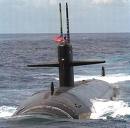|
The Los Angeles class, US Navy`s nuclear `hunter killer` submarine
 In the late 1960s the US Navy became increasingly concerned about the threat to its carrier battle groups posed by the new generation of Soviet submarines, and in particular the Charlie class SSGN with its SS-N-7 `pop up` missile. The most effective counter to soviet tactics would be to station attack submarine ahead of the battle group to detect the Soviet missile boats as they took up their attacking stations-thus was born the `close support` mission which provided the rational for the development of the Los Angeles class. In the late 1960s the US Navy became increasingly concerned about the threat to its carrier battle groups posed by the new generation of Soviet submarines, and in particular the Charlie class SSGN with its SS-N-7 `pop up` missile. The most effective counter to soviet tactics would be to station attack submarine ahead of the battle group to detect the Soviet missile boats as they took up their attacking stations-thus was born the `close support` mission which provided the rational for the development of the Los Angeles class.
The Los Angeles class specifically included ASW (Anti Submarine Warfare) against Soviet submarines trying to sink the US carrier and ASUW (Anti Surface Unit Warfare) against capital ships in the Soviet surface action group. The Los Angeles class was designed almost exclusively for Carrier Battle group escort; they were fast, quiet, and could launch Mk48 and ADCAP torpedoes, Sub Harpoon Anti-Ship Missiles (no longer carried), and both TLAM-land attack and TASM- anti-ship (no longer carried) Tomahawk cruise missiles. The new submarines showed another step improvement in quieting and an increase in operating speed to allow them to support the CVBG (Carrier Battle Group). Escort duties included conducting ASW sweeps hundreds of miles ahead of the CVBG and conducting attacks against the SAG (Soviet surface Action Group).
Submarines of the Los Angeles class are among the most advanced undersea vessels of their type in the world. While anti-submarine warfare is still their primary mission, the inherent characteristics of the submarine`s stealth, mobility and endurance are used to meet the challenges of today`s changing global geopolitical climate. Submarines are able to get on station quickly, stay for an extended period of time and carry out a variety of missions including the deployment of special forces, mine laying, and precision strike land attack.
Specifications, USS Los Angeles SSN-688, Los Angeles class:
The Los Angeles design marked the final transition from the `air ship` hull form of the Albacore and Skipjack to the cylindrical configuration which is the current hull form for all US submarines. The cylindrical middle body is almost as efficient as a continuously curved hull, and it is much easier and chipper to build or replace if needed.
Displacement (srf/sub tons): 6,082/6,927
Dimensions (L*B*D feet/meter): 362`0*33`0*32`4/110.3*10.1*9.9
Propulsion: 1*General Electric S6G Pressurized Water Reactor (PWR) 32,500hp, 2*geared steam turbine, one screw
Speed (sub knots): 32+
Range (srf/sub miles@knots): not relevant
Diving depth (feet/meter): 1475/450
Complement: 13 officers 120 enlisted
Missile: 12*VTL (Vertical Tube Launcher) in front of the fin structure capable of launching Mc Donnell Douglas Sub Harpoon, SSM sub-launched anti-ship missiles or General Dynamics/Hughes Tomahawk cruise missiles TLAM for land attack or TASM for anti ship
Torpedo: 4*21" (533 mm) torpedo tubes amidship aft of bow sonar, total of 24 torpedoes or missiles Harpoon/Tomahawk reloads.
Armament: none
Mines: can lay MK67 Mobile and MK 60 Captor-in place of torpedo
Construction
A total of 62! hulls were constructed under this class by Newport News Shipbuilding & Dry-dock Co., Newport News, VA and by Electric Boat Div., General Dynamics Corp., Groton, CT, making this the largest class of nuclear submarine ever built.
These submarines were built in three successive variants:
SSNs 688-718 - Original Los Angeles class, all launched between April 1974 and September 1983.
SSNs 719-725 and 750 all launched between August 1984 and July 1986- Starting with SSN 719 and beyond the last 31 hulls of the class have 12 vertical launch tubes for the Tomahawk cruise missile, along with an upgraded reactor core.
SSNs 751-773 - The final 23 hulls referred to as `688I` (for improved) all launched between December 1986 and April 1995, are quieter, incorporate an advanced BSY-1 sonar suite combat system and the ability to lay mines from their torpedo tubes. They are configured for under-ice operations in that their forward diving planes have been moved from the sail structure to the bow and the sail has been strengthened for breaking through ice.
Back to History Index
 |
United States |
2000 |
100th anni' of US Submarine Force,Simon Lake 1866-1945, Groton CT, 27 March 2000 |
 |
United States |
2000 |
100th anni' of US Submarine Force,Simon Lake 1866-1945, Groton CT, 27 March 2000 |
 |
United States |
2000 |
Los Angeles class (Uss Los Angeles SSN-688), Groton CT, 27 March, 2000 |
 |
United States |
2000 |
Los Angeles class (Uss Los Angeles SSN-688), Groton CT, 27 March, 2000 |
 |
United States |
2000 |
Los Angeles class (USS Los Angeles SSN-688). The number on the sail of this Los Angeles class submarine is 709 – this corresponds to USS Hyman G.Rickover SSN-709. |
 |
United States |
2000 |
Ohio class (USS Ohio SSBN-726) |
 |
United States |
2006 |
USS Scranton SSN-756, Los Angeles class submarine (private issue/zazzle.com), 2006 |
 |
Saint Thomas |
2006 |
Submarine fin breaking through the ice cup (US Los Angeles class SSN) |
 |
Malawi |
2010 |
Los Angeles class, SSN-668 (US Fast Attack Submarine, SSN, 668 class, 1976) |
|